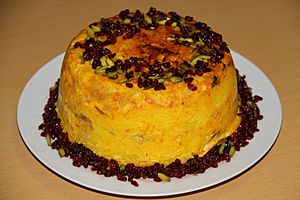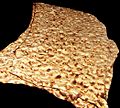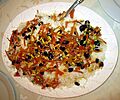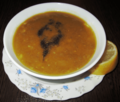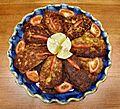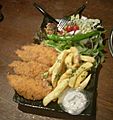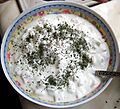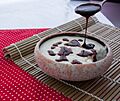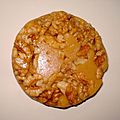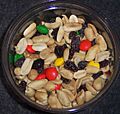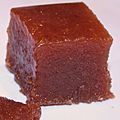List of Iranian foods facts for kids
Welcome to the delicious world of Iranian cuisine! This is a list of some amazing foods and dishes from Iran. Iranian food has a long history, sharing flavors and cooking styles with countries nearby like Turkey, Greece, and parts of Central Asia. Over time, Iranian cooking also influenced foods in India and Pakistan.
Iranian main dishes often mix rice with tasty meat, fresh vegetables, and crunchy nuts. You'll find lots of herbs and fruits like plums, pomegranates, and apricots in their meals. Special Iranian flavors include saffron (a golden spice), dried lime (for a sour kick), cinnamon, and turmeric. If you visit cities like London or Los Angeles, you might find many Iranian restaurants!
Contents
Iranian Foods
Breads of Iran
In Iran, bread is a super important part of every meal. Here are some popular types:
- Lavash: This bread is very thin, round, or oval, and a bit flaky. It's one of the most common breads in Iran.
- Sangak: This is a flatbread that's usually rectangular or triangle-shaped. It's special because it's baked on hot stones, which gives it a unique texture.
- Taftun: A soft, round flatbread that's a bit thicker than lavash.
- Tanur bread: This bread is baked in a special oven called a tanur.
- Qandi bread: A sweet bread, sometimes like a brioche.
- Barbari: A thick, oval-shaped flatbread.
- Baguette: A long, narrow French bread often filled with sausages and vegetables in Iran.
- Sheermal: This is a sweet pastry-bread, also known as nan-e gisou.
- Komaj: A sweet date bread with turmeric and cumin, similar to nan-e gisou.
Rice Dishes
Rice is a main part of Iranian meals, cooked in special ways to make it fluffy and delicious.
- Polow and Chelow:
- Chelow is plain, fluffy rice served with stews or kebabs.
- Polow is rice mixed with other ingredients like meat, vegetables, or fruits.
- Both are cooked by first boiling the rice in salted water, then draining it, and finally steaming it. This makes the rice grains separate and not sticky.
- A famous crispy layer called tadig forms at the bottom of the pot. It's often made with a thin layer of bread or potato slices, and it's super popular!
- Kateh: This rice is cooked until all the water is soaked up. It's a traditional dish from Gilan Province.
- Dami: Similar to kateh, but other ingredients like grains or beans are added at the start and cooked with the rice. You can also get tadig with dami if cooked long enough.
- Tachin: A special type of dami. It's a rice cake made with yogurt, chicken (or lamb), rice, saffron, and egg yolks.
Popular Polow and Dami Dishes
- Sabzi polow: Rice mixed with chopped herbs, often served with fish.
- Lubia polow: Rice with green beans and minced meat.
- Albalu polow: Rice with sour cherries and chicken or red meat slices.
- Morasa polow: This rice is "jewelled" with colorful ingredients like barberries, pistachios, raisins, carrots, and orange peel.
- Shirin polow: Rice with sweet carrots, raisins, and almonds.
- Adas polow: Rice with lentils, raisins, and dates.
- Baghala polo: Rice with fava beans and dill weed.
- Dampokhtak: Turmeric rice with lima beans.
- Tachin: A rice cake with yogurt, egg, and chicken fillets.
- Kabuli polow: Rice with raisins, carrots, and beef or lamb.
- Kalam Polow: Rice with cabbage and different herbs.
- Zereshk Polow: Rice with berberis (a type of berry) and saffron.
Kebabs
Kebabs are grilled meat dishes, very popular in Iran!
- Kabab koobideh: Barbecued ground lamb or beef mixed with parsley and onion.
- Juje kabab: Grilled chunks of chicken, one of the most common dishes.
- Kabab barg: Barbecued and marinated lamb, chicken, or beef.
- Kabab torsh: A traditional kebab from Gilan Province and Mazandaran Province. It's marinated in a paste of crushed walnuts, pomegranate juice, and olive oil.
- Kabab Bakhtyari: A mix of barbecued lamb (or veal) fillet and chicken breast.
- Chenje: Skewered and grilled cubes of meat, similar to shish kebab.
- Shashlik: Another popular form of shish kebab, usually with large chunks of meat.
- Kabab tabei: Homemade grilled meat, cooked on a pan.
- Bonab kabab: A type of kebab made from ground lamb, onion, and salt, from the city of Bonab.
Stews
Iranian stews, called khoresh, are rich and flavorful, often served with chelow (plain rice).
- Khoresh e bademjan: Eggplant stew with tomato, Verjuice (sour grape juice), and saffron.
- Khoresh e fesenjan: A unique stew flavored with pomegranate syrup and ground walnuts.
- Khoresh e qeyme: A stew with split peas, French fries, and dried lime.
- Qorme sabzi: A famous stew with lots of herbs like leek, cilantro, and dried fenugreek.
- Khoresh e karafs: Stewed celery and meat.
- Khoresh e alu: Stewed prunes and meat.
- Khoresh e alu-esfenaj: Stewed prunes, spinach, and meat.
- Khoresh e havij: Stewed carrots and meat.
- Khoresh e qarch: Mushroom stew.
- Baqala qatoq: A stew from Gilan with fava beans, dill, and eggs.
- Dizi: A hearty mutton stew with chickpeas and potatoes.
- Kufte rize: An Azerbaijani and Kurdish meatball stew.
Soups and Āsh
Āsh are thick Iranian soups, often packed with legumes, herbs, and noodles.
- Sup e morgh: Chicken and noodle soup.
- Sup e jow: Barley soup.
- Sirabi: Tripe soup, also known as sirab shirdun.
- Tarkhine: A grain and yoghurt soup.
- Gazane: Nettle soup.
- Adasi: Lentil soup.
- Āsh e reshte: A thick noodle soup.
- Āsh e anār: A thick pomegranate soup.
- Āsh e doogh: A thick buttermilk soup.
- Kalle Joosh: A thick soup made with Kashk (a type of dried yogurt).
- Bozbash: Meat soup with red or white beans, green vegetables, herbs, onions, and dried limes.
- Shole: A thick soup from Mashhad with meat, different legumes, wheat bulgur, rice, and spices.
Other Main Dishes
- Kuku: Like a thick omelette, made with whipped eggs mixed with herbs or potato.
- Kotlet: A fried mixture of ground beef, mashed potato, and onion.
- Salad Olvie: A salad with potato, eggs, peas, and diced chicken (or sausage), dressed with mayonnaise.
- Caviar: Salt-cured fish eggs, a luxury food.
- Dolme: Stuffed peppers or vine leaves filled with rice and meat.
- Kufte: Meatball or meatloaf dishes.
- Zaban: Beef tongue.
- Pache: Boiled parts of cow or sheep, also known as khash.
- Pirashki: Baked or fried buns filled with different ingredients.
- Sosis bandari: A traditional sausage dish with onion, tomato paste, and chili pepper.
- Nargesi: A type of spinach omelette.
- Sirabij: A type of garlic omelette.
- Gondi: An Iranian Jewish dish made of meatballs.
- Iranian pizza: A typical Iranian style pizza.
- Dopiaza: A traditional Shiraz curry made with lots of onions.
- Joshpara: Azerbaijani meat-filled dumplings.
- Shenitsel: Fried breaded meat.
- Tomato scrambled eggs: A simple dish made from eggs and tomato.
- Jaqur-Baqur: A dish made from sheep's heart, liver, and kidney.
- Biryan: A traditional dish from Isfahan made from minced meat, fat, onion, cinnamon, saffron, walnut, and mint, served with baked lung.
Appetizers
These are small dishes or snacks eaten before the main meal.
- Torshi: A mixed pickles salad, often sour.
- Salad Shirazi: A refreshing salad with chopped cucumbers, tomato, and onion, dressed with verjuice and lemon juice.
- Borani: Yogurt mixed with spinach and other ingredients.
- Mast o khiar: Strained yogurt with cucumber, garlic, and mint.
- Sabzi: Fresh herbs and raw vegetables, often served with meals.
- Zeytoon Parvardeh: Olives mixed in a paste made of pomegranate, walnut, and garlic.
- Mirza Qasemi: Grilled eggplant mixed with egg, garlic, and tomato.
- Kashk e bademjan: A mixture of kashk (dried yogurt), eggplant, and mint.
Desserts
Sweet treats to finish your meal!
- Fereni: Sweet rice pudding flavored with rose water.
- Sholezard: A delicious saffron rice-based dessert.
- Halva: Made from wheat flour and butter, flavored with rose water.
- Bastani e zaferani: Traditional saffron ice cream.
- Falude: Thin vermicelli noodles mixed in a semi-frozen syrup of sugar and rose water.
- Sarshir: A creamy dairy product similar to clotted cream.
- Liqvan and feta: Brined curd cheese, often eaten for breakfast.
- Samanu: A sweet paste made from germinated wheat, traditionally served for Nowruz (Persian New Year).
Snacks
- Koluche: Cookies, especially famous from Fuman and Lahijan.
- Bamie: Deep-fried dough soaked in sugar syrup.
- Baqlava: A pastry made of thin filo dough, nuts, and sugar syrup.
- Reshte khoshkar: Fried and spiced rice flour and walnut.
- Nougat and gaz: Sweets made of sugar, nuts, and egg white.
- Sohan: Saffron brittle candy with nuts.
- Sohan asali: Brittle candy made with honey.
- Nan-e berenji: Rice flour cookies.
- Tabrizi Lovuez: Diamond-shaped sweets made of almond powder, sugar, and saffron.
- Nokhodchi: Chickpea cookies.
- Qottab: Almond-filled deep-fried pastry.
- Kolompe: A Pie made of dates and cardamom.
- Nabat chubi: Rock candy, often flavored with saffron in Iran.
- Pashmak: Cotton candy.
- Trail mix: A mix of Dried fruit, grains, and nuts.
- Quince cheese: A sweet paste made of quince and sugar.
- Ajil e Moshkel-gosha: A traditional packed trail mix for Nowruz.
- Gush e fil: Dough topped with pistachios and powdered sugar.
- Poolaki: Thin candy made of sugar, water, and white vinegar.
- Baslogh: Pastry made of grape syrup, starch, and almond.
Drinks
- Doogh: A cold yogurt drink, often a bit salty and fizzy.
- Pomegranate juice: A popular fruit juice.
- Carrot juice: Sometimes mixed with ice cream for a special treat.
- Khakshir: A cold sweet drink with Descurainia sophia seeds.
- Sekanjebin: A cold drink made of honey and vinegar, often served with cucumber.
- Sharbat: Cold and sweet drinks made from fruits or flower petals.
- Shiraz wine: Wine produced from Shiraz grapes around the city of Shiraz in Iran.
Images for kids
-
Ტოლმა (1).jpg
Dolme
See also


